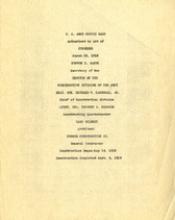Frank Caldwell Hershberger Papers

The papers were assembled by Colonel Frank Caldwell Hershberger (1888-1965) over a long international career as a veterinary medicine specialist. The bulk of the collection consists of photographs and postcards gathered into three scrapbooks dating from 1908-circa 1955. These albums cover various locations in Europe and Africa, as well as Diamond, Wyoming, and the Philippines. Additional loose photographs date from circa 1905 and document his time at the University of Missouri, Camp Marfa (Texas), Fort Monroe (Virginia), Fort Riley (Kansas), Fort Sill (Oklahoma), and Fort Mills (Corregidor, Philippines). Photographs include military officers, military polo teams, training cavalry horses, and the process of transporting horses via troopship. Augmenting the visual materials are articles, diplomatic papers, typescripts, some correspondence, and a diary related to Hershberger’s work for the Chinese government (1914-1918). One typescript details the history of the Port Veterinarian for the Port of Embarkation, New York, 1921-1945. The collection also includes the Legion of Merit medal, Legionnaire degree, which is given for exceptionally meritorious conduct in the performance of outstanding services and achievements.
